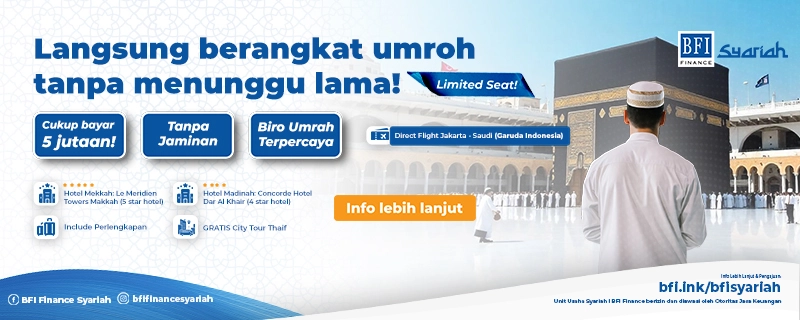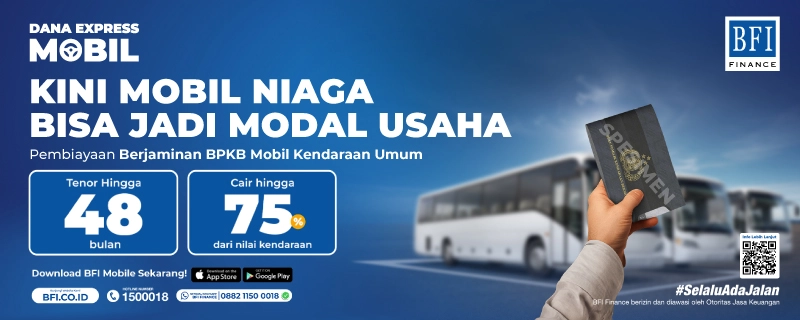Bus transportation in Indonesia is very diverse and plays a vital role in the mobility of its people. Buses are used for various purposes, from urban commutes to inter-provincial travel. A bus is a large motor vehicle designed to carry many passengers, with four or more wheels.
Over time, many types of buses have emerged in the country. Many of the buses in circulation are increasingly stylish and luxurious. So, what are the types of buses in Indonesia? Find out more in this BFI Finance article.
1. Types of Buses Based on Capacity
Bus capacity in Indonesia can be categorized into several categories, from big buses with large capacities to medium buses which are smaller.
1.1 Big Bus
A big bus is a large type of bus capable of carrying many passengers in one trip. Here are some types of big buses:
1.1.1 Normal Deck Bus
A normal deck bus has a single deck or floor. This is the most common type of bus used in Indonesia for various long-distance and short-distance routes. Its capacity is usually between 40 and 60 passengers.
1.1.2 Double Decker Bus
A double-decker bus has two floors or decks, allowing it to carry more passengers than a normal deck bus. This type of bus is usually used for long-distance routes and offers better views for passengers on the upper deck. The capacity of a double-decker bus can reach 70 to 80 passengers.
1.1.3 High Decker Bus
A high-decker bus has a higher deck than usual, providing more luggage space below the passenger deck. This makes this type of bus taller, about 3.4 to 3.5 meters. This type of bus is popular for intercity travel due to its large luggage capacity and additional passenger comfort. Its capacity is around 45 to 55 passengers.
1.1.4 Ultra High Decker Bus
An ultra-high decker bus has a very high deck, even higher than a high decker. The height of this bus can reach 4 meters. This type of bus offers maximum comfort with spacious cabin space and often comes with luxurious facilities such as fully reclining seats. Its capacity can reach 50 to 60 passengers.
1.1.5 Super High Decker Bus
This bus is usually used for exclusive services with premium facilities, such as seats that can be converted into beds. With luxurious interiors and a bus height of up to 3.9 meters, this bus has large luggage space and prioritizes passenger comfort.
1.1.6 High Decker Double Glass Bus
A high decker double glass bus has two layers of glass on a higher deck. This provides a wider view and enhances passenger comfort with better natural lighting. This type of bus is an advanced version of the super high decker with a futuristic design.
1.2 Medium Bus
A medium bus is a type of bus with medium capacity, ideal for routes that do not require large capacity but still need comfort and efficiency.
1.2.1 Micro Bus
A micro bus is a type of bus with smaller capacity, usually able to carry around 20 to 30 passengers. This type of bus is suitable for urban or short intercity routes. The micro bus is known for its maneuverability and suitability for small groups or special services.
1.2.2 Mini Van
A mini van is a smaller vehicle than a micro bus, often used for small group travel or as a shuttle within the city. Its capacity is usually around 7 to 15 passengers. Mini vans are commonly used for private transportation, family trips, or small group tours. Mini vans are known for their comfort, convenience, and flexibility for small groups like families.
1.2.3 Electric Bus
An electric bus is the latest innovation in bus transportation, using electric power as an energy source. This type of bus is environmentally friendly and increasingly popular in large cities to reduce air pollution. The capacity of electric buses varies, but they generally can carry between 25 and 50 passengers.
2. Types of Buses Based on Facilities
Buses in Indonesia can also be categorized based on the facilities offered, from the most basic to the most luxurious.
2.1 Economy Bus
An economy bus is a type of bus that offers basic facilities at affordable ticket prices. It is usually equipped with standard seats and minimal facilities such as fans or air conditioning. Its capacity ranges between 40 and 60 passengers. These buses are widely used by the public for daily commutes.
2.2 VIP Bus
A VIP bus offers better facilities than an economy bus, including more comfortable seats, air conditioning, and onboard entertainment such as TV or music players. The capacity of VIP buses is usually between 30 and 50 passengers. This type of bus is suitable for passengers who want more comfort during the journey.
2.3 Executive Bus
An executive bus is a type of bus with premium facilities, including reclining seats, ample legroom, food and beverage services, and personal entertainment. Its capacity is usually between 20 and 40 passengers. This type of bus is often used for long-distance travel with a high level of comfort.
3. Types of Buses Based on Routes
Bus routes are also an important factor in the classification of buses in Indonesia.
3.1 Inter-City Inter-Province Bus (AKAP)
An AKAP bus serves routes between cities located in different provinces. These routes are usually long and require a long travel time. AKAP buses are often equipped with adequate facilities to ensure passenger comfort during the journey. The capacity of AKAP buses varies depending on the type of bus used, but generally ranges between 40 and 60 passengers.
3.2 Inter-City Inter-County Bus (AKAB)
An AKAB bus serves routes between cities within the same province but in different counties. This type of bus is generally used by passengers traveling moderate distances. Its capacity is usually between 30 and 50 passengers.
3.3 City Bus
A city bus serves routes within one city or metropolitan area. This type of bus usually has a high departure frequency and functions as the main public transportation in large cities. The capacity of city buses varies, but generally ranges between 30 and 50 passengers.
4. Types of Buses Based on Operators
Bus operators in Indonesia consist of various types, including government-owned and private companies.
4.1 State-Owned Enterprises (BUMN) and Regional-Owned Enterprises (BUMD)
Buses operated by State-Owned Enterprises (BUMN) include companies such as Damri and Transjakarta. Typically, BUMN bus operators have guaranteed services.
4.1.1 Damri
Damri is one of the oldest and largest bus operators in Indonesia, providing bus services for various routes including urban, intercity, and inter-provincial routes. Damri also operates airport buses in several major cities. The capacity of Damri buses varies depending on the type of route served, but generally ranges between 40 and 60 passengers.
4.1.2 Transjakarta

Transjakarta is a bus rapid transit (BRT) system operating in Jakarta. Transjakarta is managed by the local government and provides city bus services with dedicated lanes allowing for faster and more efficient travel. The capacity of Transjakarta buses is usually between 80 and 100 passengers, given that these buses are designed to quickly transport large numbers of passengers.
4.2 Private Buses
In addition to BUMN operators, many private companies operate bus services in Indonesia. Private bus operators often offer various types of services, ranging from economy buses to executive buses, to meet different passenger needs.
4.2.1 Private Operators
Some well-known private bus operators in Indonesia include:
- PO Haryanto: Known for its AKAP services connecting various cities in Java and Sumatra. The capacity of PO Haryanto buses usually ranges between 40 and 60 passengers.
- Rosalia Indah: Provides executive bus services with complete facilities. The capacity of Rosalia Indah buses ranges between 30 and 50 passengers.
- Lorena: Known for its extensive network covering many major cities in Indonesia. The capacity of Lorena buses generally ranges between 40 and 60 passengers.
Bus types in Indonesia vary greatly in terms of capacity, facilities, routes, and operators. With the various options available, passengers can choose the type of bus that best suits their needs and preferences.
Currently, BFI Finance provides financing for the purchase of bus units of certain types in the Sulawesi and Java regions. If you want to apply for bus financing for various needs, BFI Finance is your answer. BFI Finance is a financing company that provides multipurpose loans with collateral such as car BPKB, motorcycle BPKB, and house or shop certificates for your needs. With competitive interest rates, BFI Finance offers loan disbursements of up to 80% of the value of your vehicle. Apply for your financing now at BFI Finance!






